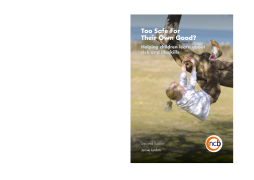
Additional Information
Book Details
Abstract
Young children have a limited understanding of the risks surrounding them: they fall over, bang their heads, scrape their knees and worse. Parents and practitioners can try to create a risk-free environment, but this can reduce children's chances to to learn about risk and how to judge new situations.
This bestselling guide shows how adults can share their own skills with young children to promote understanding of safety in a stimulating way. It covers key areas such as: putting risk into perspective; how children learn to take care of themselves; supporting children after accidents and avoiding preventable accidents; and working in partnership with parents. This second edition has been fully updated to reflect current practice, featuring new material on risk-benefit analysis and the importance of outdoor experiences.
Too Safe for Their Own Good? will support any practitioner working with children under the age of 8 with the guidance they need to offer enough challenge to benefit children, and to avoid over-protection or careless practice.
Jennie Lindon is a chartered psychologist and early years consultant. She has run her own training and consultancy business for most of her professional career and has specialised in working with services for children and their families, in particular children under five years old. She has written over 30 books, and is committed to writing about best practice that shows active respect for the needs and perspective of children and young people.
This is a very welcome second edition of a book that has been enormously popular since it was first published over 10 years ago. The theme of the book - the importance of helping young children to learn about risk and life skills - has not changed, but the text has been completely reworked to ensure it fully reflects current thinking and key issue. There are new examples to learn from, many of which look at current approaches to promoting young children's learning in and through nature.
The author speaks authoritatively and convincingly about the importance of young children being able to learn through practical experiences how to manage risk in order to keep themselves safe. This, along with the many practical examples quoted, is of enormous help to the practitioner searching for ways to ensure they fulfil their responsibility for 'teaching children step by step how to keep themselves safe'.
This book is highly recommended for use in every early years setting and, as it covers the age range up to eight, every primary school too.
Early Years Update 94: December 2011/January 2012
